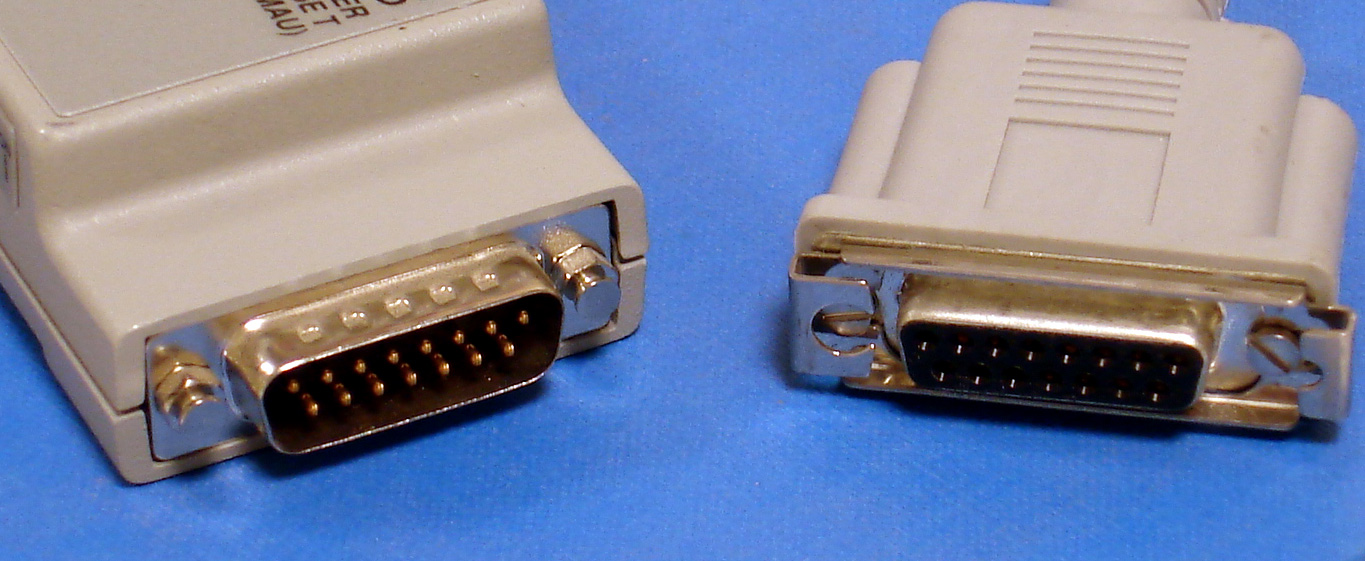|
NE1000
The NE1000 and NE2000 are members of an early line of low cost Ethernet network cards introduced by Novell in 1987. Their popularity had a significant impact on the pervasiveness of networks in computing. They are based on a reference design from National Semiconductor using their 8390 Ethernet chip. History In the late 1980s, Novell was looking to shed its hardware server business and transform its flagship NetWare product into a PC-based server operating system that was agnostic and independent of the physical network implementation and topology (Novell even referred to NetWare as a NOS, or ''network operating system''). To do this, Novell needed networking technology in general — and networking cards in particular — to become a commodity, so that the server operating system and protocols would become the differentiating technology. Most of the key pieces of this strategy were already in place: Ethernet and Token Ring (among others) had been codified by the I ... [...More Info...] [...Related Items...] OR: [Wikipedia] [Google] [Baidu] |
Novell
Novell, Inc. () was an American software and services company headquartered in Provo, Utah, that existed from 1980 until 2014. Its most significant product was the multi-platform network operating system known as NetWare. Novell technology contributed to the emergence of local area networks, which displaced the dominant mainframe computing model and changed computing worldwide. Under the leadership of chief executive Ray Noorda, NetWare became the dominant form of personal computer networking during the second half of the 1980s and first half of the 1990s. At its high point, NetWare had a 63 percent share of the market for network operating systems and by the early 1990s there were over half a million NetWare-based networks installed worldwide encompassing more than 50 million users. Novell was the second-largest maker of software for personal computers, trailing only Microsoft Corporation, and became instrumental in making Utah Valley a focus for technology and softw ... [...More Info...] [...Related Items...] OR: [Wikipedia] [Google] [Baidu] |
Ethernet
Ethernet ( ) is a family of wired computer networking technologies commonly used in local area networks (LAN), metropolitan area networks (MAN) and wide area networks (WAN). It was commercially introduced in 1980 and first standardized in 1983 as IEEE 802.3. Ethernet has since been refined to support higher bit rates, a greater number of nodes, and longer link distances, but retains much backward compatibility. Over time, Ethernet has largely replaced competing wired LAN technologies such as Token Ring, FDDI and ARCNET. The original 10BASE5 Ethernet uses a thick coaxial cable as a shared medium. This was largely superseded by 10BASE2, which used a thinner and more flexible cable that was both less expensive and easier to use. More modern Ethernet variants use Ethernet over twisted pair, twisted pair and fiber optic links in conjunction with Network switch, switches. Over the course of its history, Ethernet data transfer rates have been increased from the original to the lates ... [...More Info...] [...Related Items...] OR: [Wikipedia] [Google] [Baidu] |
Microsoft Windows
Windows is a Product lining, product line of Proprietary software, proprietary graphical user interface, graphical operating systems developed and marketed by Microsoft. It is grouped into families and subfamilies that cater to particular sectors of the computing industry – Windows (unqualified) for a consumer or corporate workstation, Windows Server for a Server (computing), server and Windows IoT for an embedded system. Windows is sold as either a consumer retail product or licensed to Original equipment manufacturer, third-party hardware manufacturers who sell products Software bundles, bundled with Windows. The first version of Windows, Windows 1.0, was released on November 20, 1985, as a graphical operating system shell for MS-DOS in response to the growing interest in graphical user interfaces (GUIs). The name "Windows" is a reference to the windowing system in GUIs. The 1990 release of Windows 3.0 catapulted its market success and led to various other product families ... [...More Info...] [...Related Items...] OR: [Wikipedia] [Google] [Baidu] |
Attachment Unit Interface
The Attachment Unit Interface (AUI) is a physical and logical interface defined in the IEEE 802.3 standard (additionally published in FIPS PUB 107) for 10BASE5 Ethernet and the earlier DIX standard. The physical interface consists of a 15-pin D-subminiature connector that links an Ethernet node's physical signaling to the Medium Attachment Unit (MAU), sometimes referred to as a transceiver. An AUI cable can extend up to , though often the MAU and data terminal equipment's (DTE) medium access controller (MAC) are directly connected, bypassing the need for a cable. In Ethernet implementations where the DTE and MAU are combined, the AUI is typically omitted. The IEEE 802.3 specification officially defines the AUI as an interconnect between a DTE and the MAU. However, devices like the DEC Digital Ethernet Local Network Interconnect (DELNI) provided hub-like functionality using AUI-compatible connectors. Additionally, under certain conditions, it was possible to directly connect ... [...More Info...] [...Related Items...] OR: [Wikipedia] [Google] [Baidu] |
Ethernet Over Twisted Pair
Ethernet over twisted-pair technologies use twisted-pair cables for the physical layer of an Ethernet computer network. They are a subset of all Ethernet physical layers. Early Ethernet used various grades of coaxial cable, but in 1984, StarLAN showed the potential of simple unshielded twisted pair. This led to the development of 10BASE-T and its successors 100BASE-TX, 1000BASE-T, 10GBASE-T and 40GBASE-T, supporting speeds of 10 and 100 megabit per second, then 1, 10 and 40 gigabit per second respectively. Two new variants of 10 megabit per second Ethernet over a ''single'' twisted pair, known as 10BASE-T1S and 10BASE-T1L, were standardized in IEEE Std 802.3cg-2019. 10BASE-T1S has its origins in the automotive industry and may be useful in other short-distance applications where substantial electrical noise is present. 10BASE-T1L is a long-distance Ethernet, supporting connections up to 1 km in length. Both of these standards are finding applications implementi ... [...More Info...] [...Related Items...] OR: [Wikipedia] [Google] [Baidu] |
3Com
3Com Corporation was an American digital electronics manufacturer best known for its computer network products. The company was co-founded in 1979 by Robert Metcalfe, Howard Charney and others. Bill Krause joined as President in 1981. Metcalfe explained the name 3Com was a contraction of "Computer Communication Compatibility", with its focus on Ethernet technology that he had co-invented, which enabled the networking of computers. 3Com provided network interface controller and switches, routers, wireless access points and controllers, IP voice systems, and intrusion prevention systems. The company was based in Santa Clara, California. From its 2007 acquisition of 100 percent ownership of H3C Technologies Co., Limited (H3C) —initially a joint venture with China-based Huawei Technologies—3Com achieved a market presence in China, and a significant networking market share in Europe, Asia, and the Americas. 3Com products were sold under the brands 3Com, H3C, and TippingPoi ... [...More Info...] [...Related Items...] OR: [Wikipedia] [Google] [Baidu] |
Linux
Linux ( ) is a family of open source Unix-like operating systems based on the Linux kernel, an kernel (operating system), operating system kernel first released on September 17, 1991, by Linus Torvalds. Linux is typically package manager, packaged as a Linux distribution (distro), which includes the kernel and supporting system software and library (computing), libraries—most of which are provided by third parties—to create a complete operating system, designed as a clone of Unix and released under the copyleft GPL license. List of Linux distributions, Thousands of Linux distributions exist, many based directly or indirectly on other distributions; popular Linux distributions include Debian, Fedora Linux, Linux Mint, Arch Linux, and Ubuntu, while commercial distributions include Red Hat Enterprise Linux, SUSE Linux Enterprise, and ChromeOS. Linux distributions are frequently used in server platforms. Many Linux distributions use the word "Linux" in their name, but the Free ... [...More Info...] [...Related Items...] OR: [Wikipedia] [Google] [Baidu] |
UNIX
Unix (, ; trademarked as UNIX) is a family of multitasking, multi-user computer operating systems that derive from the original AT&T Unix, whose development started in 1969 at the Bell Labs research center by Ken Thompson, Dennis Ritchie, and others. Initially intended for use inside the Bell System, AT&T licensed Unix to outside parties in the late 1970s, leading to a variety of both academic and commercial Unix variants from vendors including University of California, Berkeley ( BSD), Microsoft (Xenix), Sun Microsystems ( SunOS/ Solaris), HP/ HPE ( HP-UX), and IBM ( AIX). The early versions of Unix—which are retrospectively referred to as " Research Unix"—ran on computers such as the PDP-11 and VAX; Unix was commonly used on minicomputers and mainframes from the 1970s onwards. It distinguished itself from its predecessors as the first portable operating system: almost the entire operating system is written in the C programming language (in 1973), which allows U ... [...More Info...] [...Related Items...] OR: [Wikipedia] [Google] [Baidu] |
FreeBSD
FreeBSD is a free-software Unix-like operating system descended from the Berkeley Software Distribution (BSD). The first version was released in 1993 developed from 386BSD, one of the first fully functional and free Unix clones on affordable home-class hardware, and has since continuously been the most commonly used BSD-derived operating system. FreeBSD maintains a complete system, delivering a kernel, device drivers, userland utilities, and documentation, as opposed to Linux only delivering a kernel and drivers, and relying on third-parties such as GNU for system software. The FreeBSD source code is generally released under a permissive BSD license, as opposed to the copyleft GPL used by Linux. The project includes a security team overseeing all software shipped in the base distribution. Third-party applications may be installed using the pkg package management system or from source via FreeBSD Ports. The project is supported and promoted by the FreeBSD Foundation ... [...More Info...] [...Related Items...] OR: [Wikipedia] [Google] [Baidu] |







